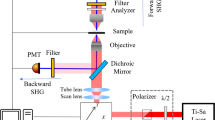Abstract
The continuous retinoblastoma cell line Y79, grown in suspension culture, has been examined by transmission and scanning electron microscopy, including freeze-fracture replica preparations. Four classes of cells were distinguishable by their size and surface characteristics. The surface structures included blebs, filopodia, lamellipodia, microvilli, and microplicae. The possible origin of a most unusual type of cell, apparently forming natural clones, is discussed.
Zusammenfassung
Die kontinuierliche Retinoblastom-Zellinie Y79, die in einer Suspensionskultur gezüchtet wurde, wurde untersucht mit Transmissions- und Rasterelektronenmikroskopie einschließlich Gefrierbruchpräparationen.
4 Klassen von Zellen waren zu unterscheiden aufgrund ihrer Größe und Oberflächenbeschaffenheit. Die Oberflächenstrukturen enthalten Blasen, Filopodien, Lamellipodien, Mikrovilli und Microplicae.
Die mögliche Herkunft eines recht ungewöhnlichen Zelltyps, der offenbar natürliche Klone produziert, wird diskutiert.
Similar content being viewed by others
References
Albert, D.M., Rabson, A.S., Dalton, A.J.: Tissue culture study of human retinoblastoma. Invest. Ophthalmol. 9, 64–72 (1970)
Breckenridge, B.M.: Regulation of cyclic nucleotide-related enzymes in an astrocytoma cell line. In: Cyclic Nucleotides in Disease, B. Weiss, ed., pp. 67–68. Baltimore: University Park Press 1975
Hanna, R.B., Hirano, A., Pappas, G.D.: Membrane specializations of dendritic spines and glia in the weaver mouse cerebellum: a freeze-fracture study. J. Cell Biol. 68, 403–410 (1976)
Huang, L.H., Sery, T.W., Chen, M.M., Cheung, A.S., Keeney, A.H.: Experimental retinoblastoma: morphology and behavior of cells cultivated in vitro. Amer. J. Ophthalmol. 70, 771–777 (1970)
Johnson, G.S.: The importance of cyclic AMP in cellular transformation. In: Cyclic Nucleotides in Disease, B. Weiss, ed., pp. 35–44. Baltimore: University Park Press 1975
Larsen, W.J.: Structural diversity of gap junctions: a review. Tissue Cell 9, 373–394 (1977)
McFall, R.C., Sery, T.W., Makadon, M.: Characterization of a new continuous cell line derived from a human retinoblastoma. Cancer Res. 37, 1003–1010 (1977)
McFall, R.C., Nagy, R.M., Nagle, B.T., McGreevy, L.M.: Scanning electron microscopic observations of two retinoblastoma cell lines. Cancer Res. 38, 2827–2835 (1978)
Ohnishi, Y.: The histogenesis of retinoblastoma: an electron-microscopic analysis of rosette. Ophthalmologica 174, 129–136 (1977)
Popoff, N., Ellsworth, R.M.: The fine structure of nuclear alterations in retinoblastoma and in the developing human retina: in vivo and in vitro observations. J. Ultrastruct. Res. 29, 535–549 (1969)
Porter, K.R., Todaro, G.J., Fonte, V.: A scanning electron microscope study of features of viral and spontaneous transformants of mouse BALB/3T3 cells. J. Cell Biol. 59, 633–642 (1973)
Prasad, K.N., Kumar, S., Becker, G., Sahu, S.K.: The role of cyclic nucleotides in differentiation of neuroblastoma cells in culture. In: Cyclic Nucleotides in Disease. B. Weiss, ed., pp. 45–66. Baltimore: University Park Press 1975
Puck, T.T.: Cyclic AMP, microtubules, microfibrils, and cancer. In: I.C.N.-U.C.L.A. Symposia on Molecular and Cellular Biology. G. Wilcox, J. Abelson, F. Fox, eds., V. 8, 399–411 1977
Rajamaran, R., Rounds, D.E., Yen, S.P.S., Rembaum, A.: A scanning electron microscope study of cell adhesion and spreading in vitro. Exp. Cell Res. 88, 327–329 (1974)
Reid, T.W., Albert, D.M., Rabson, A.S., Russell, P., Craft, J., Chu, E.W., Tralka, T.S., Wilcox, J.L.: Characteristics of an established cell line of retinoblastoma. J. Natl. Cancer Inst. 53, 347–360 (1974)
Sandri, C., Van Buren, J.M., Akert, K.: Membrane morphology of the vertebrate nervous system. In: Progress in brain research, pp. 31–38, v. 46, New York: Elsevier Sci. Publ. Co. 1977
Staehelin, L.A., Hull, B.E.: Junctions between living cells. Sci. Am. 238, 141–152 (1978)
Ts'o, M.O., Fine, B.S., Zimmerman, L.E., Vogel, M.H.: Photoreceptor elements in retinoblastoma: a preliminary report. Arch. Ophthalmol. 82, 57–59 (1969)
Vial, J., Porter, K.R.: Scanning electron microscopy of dissociated tissue cells. J. Cell Biol. 67, 345–360 (1975)
Weinstein, R.S., Merk, F.B., Alroy, J.: The structure and function of intercellular junctions in cancer. In: Advances in cancer research, G. Klein, S. Weinhouse, A. Haddon, eds., pp. 23–89, v. 23, New York: Academic Press 1976
Yoneda, C., Van Herick, W.: Tissue culture cell strain derived from retinoblastoma. Am. J. Ophthalmol. 55, 987–992 (1963)
Author information
Authors and Affiliations
Rights and permissions
About this article
Cite this article
Green, A.L.W., Meek, E.S., White, D.W. et al. Retinoblastoma Y79 cell line: A study of membrane structures. Albrecht von Graefes Arch. Klin. Ophthalmol. 211, 279–287 (1979). https://doi.org/10.1007/BF00414686
Received:
Issue Date:
DOI: https://doi.org/10.1007/BF00414686




